My favorite sail, the Leg-o-Mutton Sprit
(aka: 3 sided sprit)
by David
'Shorty' Routh
Phil Bolger designed a lot of small boats that use what is commonly
called the "Bolger 59", which is a 59 sqft leg-o-mutton
sprit sail. It is very simple to use and is easily adapted to
many different sailboat hulls.
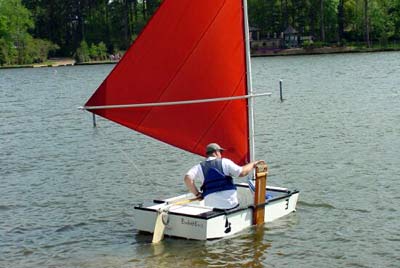
I have always loved this sail for small boats for these
reasons:
It is super simple - just a mast and
light sprit boom.
The boom is very high - so it is not
likely to konk your head. So many of the other sail rigs have
"deck sweeper" booms so you have to contort to get under
them on every tack.
Great Visibility - a function of how
high the boom is, you can see a bit better with this sail. Still
have a blind spot, but a window will fix that.
Self vanging - I am always trying to
eliminate line and complication from my boats, and a vang is just
another complication. I tried this sail using a regular boom with
jaws that ran along the foot, but gave it up for the simplicity
of the sprit.
Being 3 sided, it points very high into the wind
- and so far I have been able to beat all the square sails to
windward. I have yet to defeat Ken and his lateen sail to windward,
but I am not sure if it is the cut of my sail, the size of it,
or if Ken is just a better sailor.
To furl - just undo the snotter, point
the boom to the head of the mast, and roll the boom up in the
sail, tucking the main sheet in along the way, pull a bungee around
when done. Very easy, quick, and gets the boom, main sheet, and
snotter line out of the way. I leave it like that when stored
in the garage too.
Self Flattening - If it uses the curved
luff method for sail making, as the wind blows harder, the mast
will curve back and make the sail flatter, which is what you want.
Convert a Jib - Sometimes you can convert
a sloop jib into one of these, possibly a cheap one from ebay.
Main sheet - can either be run aft,
or fairled to come from forward. Some people prefer to have the
main sheet in one hand, and the tiller in the other, or both in
one hand. Can do either with this rig.
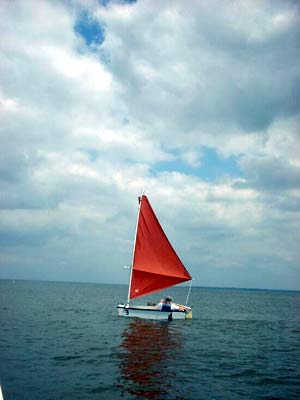
Some of the problems of this sail:
Needs a tall mast - The only hardware
store mast I know of is a 2x4x16, other than that you will either
have to laminate up a wooden mast, or make a stayed one from multiple
smaller pieces like fence post.
Has a "bad" tack - The bad
tack really isn't that bad, but you will notice it. It is the
tack where the sail lays against the boom. Best to put the boom
on the starboard side so that when you come around the windward
mark you will be on the preferred tack, and don't have to jibe.
If you are sailing somewhere and will be on the "bad tack"
for a long time, you could just swap it to the other side so it
will then be on the good tack.
It is not easy to reef - This really
isn't true, the sail can be reefed by lacing up a panel on the
bottom, but most small sails are laced to the mast in a manner
that they can't be lowered. There are methods of lacing so you
can lower the sail, and you could get sail track or an aluminum
mast with a luff groove.
Does not reach - as well as the square
sails, could fix that with a spinnaker.
The sprit will snag a jib when tacking
- so need adequate space between mast and luff of jib.
Mast blankets the luff - With most
square sails, the luff of the sail is clear so the air flows evenly
over it. With a lateen, the luff has a very small diameter yard,
so the air flows more cleanly than having a big mast in the way.
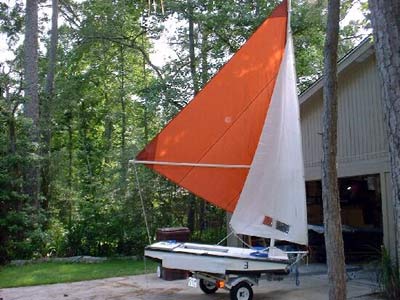
The standard size of the Bolger 59 is:
- 14'3" luff
- 13'7" leech
- 9'0" foot
Using the curved luff and foot method of shaping, having 3"
of curve at 30% back seems to work good. 59 sqft seems to be a
good size for the pdracer. If you are a heavier person, you might
consider going up to 80 sqft, or even a little bit larger.
Notice the bulge at the top of the mast, I attached a standard
boat fender as a mast head float. This will keep the boat from
going more than 90 degrees over in a knock down.
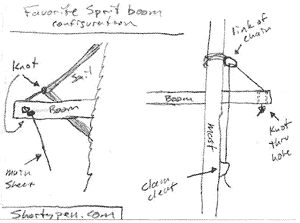
(click to enlarge)
The Snotter
It is really cool sailing around in a boat with a snotter, just
sounds neat. The snotter is basically a gooseneck for a sprit
boom. Most often it is a short piece of line that provides tension
on the forward end of the boom, the line runs from the boom end
to the mast, and then down to a cleat. The tension can either
be applied from the snotter line, or from the clew.
Some sprit sails don't have a snotter at all, they use either
a windsurfer boom or a T shaped boom that is laced to the mast,
so that the line attached to the clew provides all of the tension.
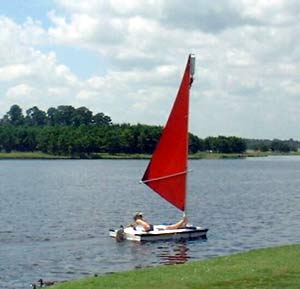

|

